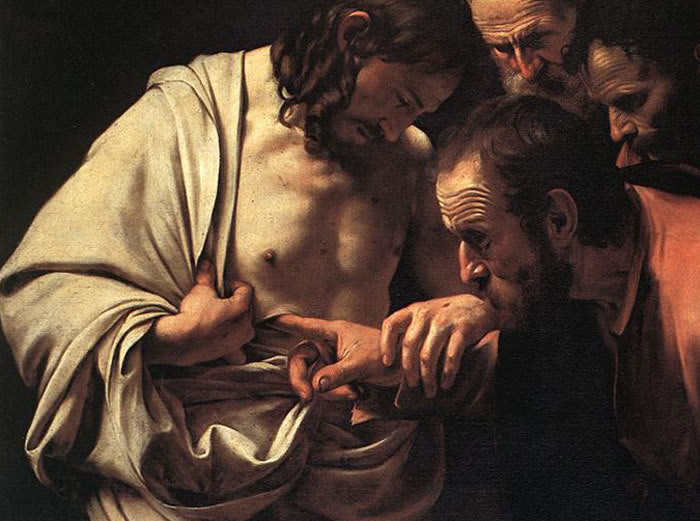In the evening of that same day, the first day of the week, the doors were closed in the room where the disciples were, for fear of the Jews. Jesus came and stood among them. He said to them, ‘Peace be with you,’ and showed them his hands and his side. The disciples were filled with joy when they saw the Lord, and he said to them again, ‘Peace be with you.
‘As the Father sent me, so am I sending you.’
After saying this he breathed on them and said:
‘Receive the Holy Spirit. For those whose sins you forgive, they are forgiven; for those whose sins you retain, they are retained.’
Thomas, called the Twin, who was one of the Twelve, was not with them when Jesus came. When the disciples said, ‘We have seen the Lord’, he answered, ‘Unless I see the holes that the nails made in his hands and can put my finger into the holes they made, and unless I can put my hand into his side, I refuse to believe.’ Eight days later the disciples were in the house again and Thomas was with them. The doors were closed, but Jesus came in and stood among them. ‘Peace be with you’ he said. Then he spoke to Thomas, ‘Put your finger here; look, here are my hands. Give me your hand; put it into my side. Doubt no longer but believe.’ Thomas replied, ‘My Lord and my God!’ Jesus said to him:
‘You believe because you can see me. Happy are those who have not seen and yet believe.’
There were many other signs that Jesus worked and the disciples saw, but they are not recorded in this book. These are recorded so that you may believe that Jesus is the Christ, the Son of God, and that believing this you may have life through his name.
Jn 20:19-31
Although there are fourteen stories about Jesus’ resurrection in the four Gospels, it is the reading from John’s Gospel (20: 19-31) that is used each year for the second Sunday of Easter. There are two distinct parts of this passage, one associated with Jesus’ outpouring of the Holy Spirit onto his disciples on the night of the resurrection, the other concerns Jesus’ appearance a week later and his encounter with the doubting Thomas.
John’s Gospel tells us that on the night of Jesus’ resurrection the disciples were gathered in fear behind locked doors. Jesus came among them and said ‘Peace be with you’ showing them the wounds of his hands and side. As the disciples rejoiced, Jesus then commissioned them to continue his mission of love through the forgiveness of sins ‘As the Father sent me so I am sending you … receive the Holy Spirit. For those sins you forgive, they are forgiven.’ The sacrament of Penance is a gift from God given to the Church by the risen Lord as the first fruit of his own death and resurrection. Given to the Apostles, Jesus’ healing love, the power to forgive sins, continues to be worked and seen through the Church today.
A particularly striking image in this passage is that of Jesus breathing the Holy Spirit upon his disciples, creating a strong parallel to Genesis 2:7 in which God breathes life into the lifeless human form. In this sense we consider that with the resurrection we are offered the gift of a new creation.
Of the fourteen resurrection accounts none actually describes Jesus’ physical appearance. What they convey however is the faith of the disciples that Jesus is alive. The Easter message today is not only that Jesus rose, but that he is risen and with us now. For many people in our world it is a matter of ‘seeing is believing’ however Jesus stated ‘Happy are those who have not seen and yet believe.’ Jesus’ encounter with the doubting Thomas resonates with many of us who have struggled at many points in our journey of faith. Often we want to be given assurances, we want to ‘see the holes that the nails made in his hands’. Like Thomas we are invited to move from scepticism and doubt to faith. Ultimately it is this faith in Jesus Christ that gives life.
Even though we cannot actually see him as the disciples did, we can encounter the living Jesus in the Sacraments and in the Word. The life of Jesus must overflow into ours and it is through regular prayer, and the reception of the sacraments, especially Penance and Holy Communion, that this encounter takes place.
Anthony Cleary
Director, Mission & Identity
